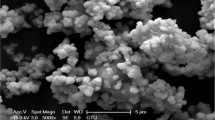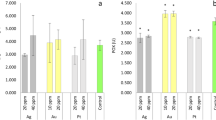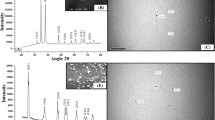Abstract
The aim of this work was to study the toxicity of nanosheet zinc oxide nanoparticle with the size of 45 nm. The penetration of nanoparticles at an exposure by a localized spray does not make it possible to understand the mechanism of transport and bioavailability of the nanoparticles. In contrast, nanoparticles penetrated, via the roots, as a function of their diameter, the smaller ones having caused leaf stress (by translocation) at low concentrations. So that the choice of method of root application. Plants treated with 50 mg L−1 of ZnO-NPs presented disturbance in leaf due to changes in chlorophyll’s biosynthesis. The highest value of the photosynthetic pigments was recorded at 5 mg L−1 of ZnO-NPs. However, the treatment with 50 mg L−1 of ZnO-NPs caused a decrease in the levels of chlorophyll a and b. Moreover, ZnO-NPs leaves significantly enhanced antioxidant enzymes activities.








Similar content being viewed by others
References
Akir S, Barras A, Coffinier Y et al (2016) Eco-friendly synthesis of ZnO nanoparticles with different morphologies and their visible light photocatalytic performance for the degradation of Rhodamine B. Ceram Int 42:10259–10265
Battke F, Leopold K, Maier M et al (2008) Palladium exposure of barley: uptake and effects. Plant Biol 10:272–276. https://doi.org/10.1111/j.1438-8677.2007.00017.x
Chen C, Yu B, Liu P et al (2011) Investigation of nano-sized ZnO particles fabricated by various synthesis routes. J Ceram Process Res 12:420–425. https://doi.org/10.1016/j.cej.2008.07.047
Çimrin KM, Türkmen Ö, Turan M, Tuncer B (2010) Phosphorus and humic acid application alleviate salinity stress of pepper seedling. Afr J Biotechnol 9:5845–5851
Dietz KJ, Herth S (2011) Plant nanotoxicology. Trends Plant Sci 16:582–589
Faisal M, Saquib Q, Alatar AA et al (2013) Phytotoxic hazards of NiO-nanoparticles in tomato: a study on mechanism of cell death. J Hazard Mater 250–251:318–332
Feng Z, Zhang B, Ding W et al (2013) Efficient genome editing in plants using a CRISPR/Cas system. Cell Res 23:1229–1232. https://doi.org/10.1038/cr.2013.114
Hassan F, Miran MS, Simol HA et al (2015) Synthesis of ZnO nanoparticle by a hybrid electrochemical-thermal method: influence of calcination temperature. Bangladesh J Sci Ind Res 50(1):21–28
Hazman M (2015) Increased tolerance to salt stress in OPDA-deficient rice allene oxide cyclase mutants is linked to an increased ROS-scavenging activity. J Exp Bot 66:3339–3352. https://doi.org/10.1093/jxb/erv142
Hoagland DR, Arnon DI, Hause B, Eiche E et al (1950) The water-culture method for growing plants without soil. Circ Calif Agric Exp Stat 347:1-32
Kayani ZN, Saleemi F, Batool I (2015) Effect of calcination temperature on the properties of ZnO nanoparticles. Appl Phys A 119:713–720
Khodakovskaya M, Dervishi E, Mahmood M, Xu Y, Li ZR, Watanabe F, Biris AS (2009) Carbon nanotubes are able to penetrate plant seed coat and dramatically affect seed germination and plant growth. ACS Nano 3:3221–3227
Koller E (2004) Traitement des pollutions industrielles. Paris 59–90,
Larue C, Khodja H, Herlin-Boime N et al (2011) Investigation of titanium dioxide nanoparticles toxicity and uptake by plants. J Phys Conf Ser 304
Lee CW, Mahendra S, Zodrow K et al (2010) Developmental phytotoxicity of metal oxide nanoparticles to Arabidopsis thaliana. Environ Toxicol Chem 29:669–675
Lewicka ZA, Yu WW, Oliva BL et al (2013) Photochemical behavior of nanoscale TiO2 and ZnO sunscreen ingredients. J Photochem Photobiol A Chem 263:24–33
Lin D, Xing B (2008) Root uptake and phytotoxicity of ZnO nanoparticles. Environ Sci Technol 42:5580–5585. https://doi.org/10.1021/es800422x
Mazhar R, Ilyas N, Saeed M et al (2016) Biocontrol and salinity tolerance potential of Azospirillum lipoferum and its inoculation effect in wheat crop. Int J Agric Biol 18:494–500. https://doi.org/10.17957/IJAB/15.0115
Missaoui T, Smiri M, Chemingui H, Hafian A (2017) Effects of nanosized titanium dioxide on the photosynthetic metabolism of fenugreek (Trigonella foenum-graecum L.). C R Biol 340:1–13
Missaoui T, Smiri M, Chemingui H et al (2018) Regulation of mitochondrial and cytosol antioxidant systems of Fenugreek (Trigonella foenum graecum L.) exposed to nanosized titanium dioxide. Bull Environ Contam Toxicol 101:326
Monica RC, Cremonini R (2009) Nanoparticles and higher plants. Caryologia 62(2):161–165
Moulahi A, Sediri F, Gharbi N (2012) Hydrothermal synthesis of nanostructured zinc oxide and study of their optical properties. Mater Res Bull 47:667–671
Oberdörster G, Stone V, Donaldson K (2007) Toxicology of nanoparticles: a historical perspective. Nanotoxicology 1:2–25
Reid JSG (1971) Reserve carbohydrate metabolism in germinating seeds of Trigonella foenum-graecum L. (Leguminosae). Planta 100:131–142
Rico C, Hong J, Morales MI, Zhao L, Barrios AC et al (2013) Effect of cerium oxide nanoparticles on rice: a study involving the antioxidant defense system and in vivo fluorescence imaging. Environ Sci Technol 47:11–33
Sageer EM, Baun A, Kästner M, Trapp S (2009) Insignificant acute toxicity of TiO2 nanoparticles to willow trees. J Soils Sediments 9:46–53. https://doi.org/10.1007/s11368-008-0034-0
Schützendübel A, Polle A (2002) Plant responses to abiotic stresses: heavy metal-induced oxidative stress and protection by mycorrhization. J Exp Bot 53:1351–1365
Shaw AK, Hossain Z (2013) Impact of nano-CuO stress on rice (Oryza sativa L.) seedlings. Chemosphere 93:906–915. https://doi.org/10.1016/j.chemosphere.2013.05.044
Siani NG, Fallah S, Rostamnejadi A (2016) Evaluation of Iinhibition effect of ZnO nanoparticles concentration regarding seed germination and seedling growth of Fenugreek (Trigonella foenum-graecum L.). J Med Plants By-prod 2:235–243
Suliman AE (2007) Preparation of ZnO nanoparticles and nanosheets and their application to dye-sensitized solar cells Sol. Energy Mat Sol Cells 91:1658
Wang RC, Tsai CC (2009) Efficient synthesis of ZnO nanoparticles, nanowalls, and nanowires by thermal decomposition of zinc acetate at a low temperature. Appl Phys A 94:241–245. https://doi.org/10.1007/s00339-008-4755-0
Wu L, Wu Y, Lu W (2005) Preparation of ZnO nanorods and optical Characterizations. Physica E 28:76–82, 2005
Zhang Y, Nayak TR, Hong H, Cai W (2013) Biomedical applications of zinc oxide nanomaterials. Curr Mol Med 13:1633–1645
Zheng L, Hong F, Lu S, Liu C (2005) Effect of nano TiO2 on strength of naturally aged seeds and growth of spinach. Biol Trace Elem Res 104:83–91
Zhu XG, Long SP, Ort DR (2008) What is the maximum efficiency with which photosynthesis can convert solar energy into biomass. Curr Opin Biotechnol 19:153–159
Acknowledgements
Financial support for this work was received from the Tunisian Ministry of Higher Education, Scientific Research, and Technology (LR15CERTE04).
Author information
Authors and Affiliations
Corresponding author
Ethics declarations
Conflict of interest
The authors declare that they have no competing interest.
Rights and permissions
About this article
Cite this article
Chemingui, H., Smiri, M., Missaoui, T. et al. Zinc Oxide Nanoparticles Induced Oxidative Stress and Changes in the Photosynthetic Apparatus in Fenugreek (Trigonella foenum graecum L.). Bull Environ Contam Toxicol 102, 477–485 (2019). https://doi.org/10.1007/s00128-019-02590-5
Received:
Accepted:
Published:
Issue Date:
DOI: https://doi.org/10.1007/s00128-019-02590-5




